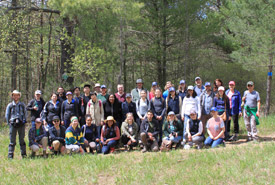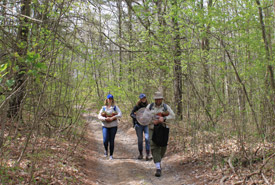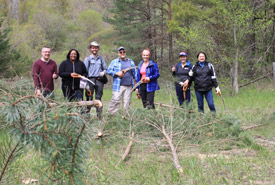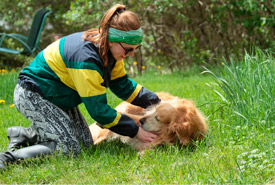Trading screens for shovels: NCC national staff lend a hand for nature

NCC National staff joined Ontario field staff for a day of planting and pulling and cutting down invasive species (Photo by NCC)
The sun was shining down on the Barr property in southern Ontario as the Nature Conservancy of Canada (NCC) national staff gathered around Todd Farrell, NCC’s conservation biology coordinator for the Ontario Region. We were learning our itinerary for our annual day out in the field: a day filled with conservation work to help restore the property.
For most of us office dwellers, it was a welcome change of scenery. We traded in meetings and emails for gardening gloves and shovels and got to work. This year, staff ventured out to the Rice Lake Plains, south of Rice Lake in the easternmost segment of the Oak Ridges Moraine. Part of the group was responsible for removing invasive spotted knapweed, another part with cutting down invasive Scotch pine and thinning native white pine and the rest, my group, with planting New Jersey tea. The latter species is one that, according to Todd, is sought after by mottled duskywing, a species at risk.

Todd Farrell leads staff to New Jersey tea planting site. (Photo by NCC)
Todd was joined by Cameron Curran, Victoria Shore and Meidan Leiderman, who are all working with NCC this summer as conservation technicians. They were all extremely informative about the species we were working with and their effects on the property.
Once noon hit, we dropped our gloves and broke for lunch. It was great to be able to chat with coworkers from different departments in the organization over PB&J sandwiches, juice boxes and fresh veggies all around. Despite working under the same roof, it’s not often that we all sit down together as a group. With the long weekend coming up, it was interesting to learn of everyone’s plans and to get a quick peek into each person’s interests and hobbies.

Staff banded together to cut down invasive Scotch pine. (Photo by NCC)
After lunch, the restoration work continued until about mid-afternoon, when staff put their tools away and laced up their hiking boots. Todd took us on a short hike around the property, where we learned about native species such as wild strawberry, and checked out the 19th century cemetery, occupied with faded tombstones and large trees. Afterward (and in my opinion this was the highlight of the trip) we paid a visit to artist Barry King and his dog, Carrie, who live on the property.
Our day out in the field gave staff the chance to forge stronger bonds with each other and with nature. This type of team building is essential in creating solid foundations across our diverse departments. From finance to marketing, each staff member at NCC plays an integral role in the organization’s conservation mission.

Author Raechel with her new friend, Carrie. (Photo by NCC)
Not only was it great to learn more about members of NCC’s national team, but we were able to lend a hand for nature by volunteering our time to help restore the Barr property. Todd reminded us that every little bit helps, and together we were able to cut 70 Scotch pine trees, plant 100 New Jersey tea plants and pull 350 square metres of knapweed.
I was happy to put my out-of-office alert on my email for the day to spend it working on one of NCC’s beautiful properties with fellow staff. Every day, I am fortunate enough to share stories with our readers from our staff and volunteers across Canada, but on that day it was my turn to be part of one of NCC’s hands-on conservation successes.


